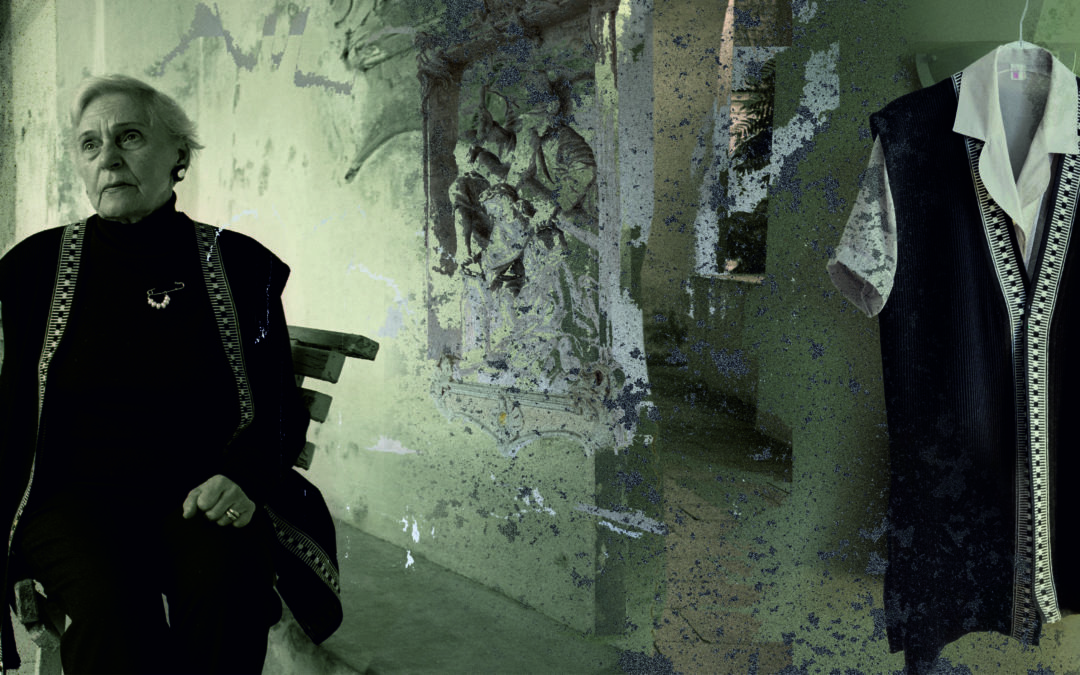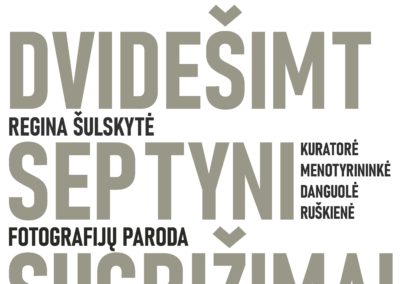Rugsėjo 29 d., penktadienį, 17 val. Šiaulių dailės galerijoje atidaroma Reginos Šulskytės fotografijų paroda „Dvidešimt septyni sugrįžimai“. Paroda veiks iki spalio 29 d.
Naujausią fotografijų seriją autorė skiria mamos atminimui. Skaičius 27 siejamas su tam tikrais R. Šulskytės mamos gyvenimo etapais: 27 – jos gimimo diena, mamai buvo 27 metai, kai gimė fotomenininkė. 27 žymi ir serijos kūrinių skaičių. Pasak parodos autorės, kiekvienoje jos fotografijoje sugrįžtama į praeitį, pratęsti nebepratęsiamą, kažką iš praeities, nors ir nežinia kaip. Šis procesas tampa savotišku išsigelbėjimu, meditacija, atsiradusių įtrūkių tikrovėje kompensacija. Tai – dialogas su savimi, išpažintis tekančiam laikui – pasitraukimas į naujų apmąstymų ir išgyvenimų teritoriją.
Fotografijų seriją autorė kūrė beveik penkis metus. Pirmiausia ją pasirinko pristatyti gimtuosiuose Šiauliuose. Paroda čia vyks iki spalio 21 d. Lapkritį ji bus eksponuojama Vilniuje, Prospekto galerijoje. Kitais metais šią parodą planuojama surengti ir kituose šalies miestuose.
Regina Šulskytė – Lietuvos fotomenininkų sąjungos narė; dirbo Kauno Stepo Žuko taikomosios dailės technikume, Šiaulių fotografijos muziejuje, dėstė fotografiją Šiaulių universiteto Menų katedroje.
Dalyvauja bendrose parodose, rengia personalines parodas Lietuvoje ir užsienyje, sudarinėja fotografijos leidinius, kuruoja parodas. Fotomenininkė pelnė tarptautinius apdovanojimus. 2005 m. ir 2009 m. – Šiaulių miesto kultūros ir meno premijų laureatė. Svarbiausi jos fotografijų ciklai: „Interpretacijos“ (1996–2003), „Mano drabužiai“ (1977–2004), „Miegamajame“ (1977–2004), „Susitikimai“ (2005), „Seserys“ (2006–2007), „Austria’07“ (2007), „Mano laikas“ (2011–2013), „Dvidešimt septyni sugrįžimai“ (2018–2023).
„Reginos Šulskytės fotografijoje visą laiką vyko balansavimas tarp asmeninių ir bendrų patirčių, išryškinančių esminius žmogaus egzistavimo momentus. Fotomenininkė savo kūryboje stebėtinai nuosekli. Jos fotografijų ciklai tarsi vieno filmo dalys – keliaujant iš vienos istorijos į kitą keičiasi laikas, kontekstai, detalės, atsiranda ir pranyksta tam tikros emocijos. Tačiau pagrindiniai herojai beveik visuomet išlieka tie patys. Antra vertus, kiekviename savo fotografijų cikle ji užaštrina vis kitą gyvenimo kampą, atidengia dar neaptartą jo sluoksnį. Stebint R. Šulskytės kūrybą susidaro įspūdis, kad autorė jau seniai išlygino svarstykles tarp būties ir nebūties, nei vienai iš jų nesuteikdama galimybės nusverti. Menininkės fotografijoje gyvenimas ir mirtis juntamas greta, tačiau didžiulės įtampos čia nestebima. Nėra ir dramos. Tai veikiau panašu į pilnatvę žadantį pasakojimą su tikroviška pabaiga, tad visiškai nestebina, kad tame pačiame kadre pradžia siejama su pabaiga, atėjimas su išėjimu, o egzistavimas jau iš anksto perspėja apie išnykimą. Visa tai iki šiol buvo ištransliuojama gana atsargiai, subtiliomis užuominomis, paliekant pakankamai erdvės paklaidoms ir individualiam istorijos adaptavimui.
Dabar jau anksčiau vyravęs delsimas tampa atviru išsipasakojimu. Ko gero, taip atrodo savęs suvokimas. Autorė turi aiškią žinutę. Viskas – praeitis ir dabartis, nerimas dėl retėjančio artimųjų rato, kai prarandami brangiausi žmonės – taip pat yra savęs formavimas, gal net esminiai jo momentai.
Žmogus, kaip ir jo gyvenimas – iš daugybės sluoksnių, gulančių metai po metų ant jo bręstančio kūno. Autorė atkreipia dėmesį į laiką, kai vietoj veržimosi į priekį vis dažniau gręžiojamasi atgal. O ateities planavimas mielai iškeičiamas į praeities apmąstymus. Ji kalba apie savo brandą ne tik kaip moters, žmogaus, bet ir kaip kūrėjos.
Naujausias R. Šulskytės ciklas „Dvidešimt septyni sugrįžimai“ (2018–2023) – natūrali jos kūrybos tąsa. Akivaizdu, kad dabar jai nereikia stimuliuoti nei jausmų, nei minčių, nes papildomos pastangos atrodytų pernelyg demonstratyviai. Užtenka remtis tikrais išgyvenimais, patirtimi ir netrukdyti jiems sugulti į fotografijų plokštumas. Galbūt todėl nekyla abejonių, kad viskas jos fotografijoje turi būti taip, o ne kitaip. Niekas čia negali nei keistis, nei koreguotis. Ar ne taip atrodo suvokimas, kad ne laikas yra mūsų rankose, bet mes jo galioje?
Vis tik neteisinga būtų teigti, kad R. Šulskytei nebeliko neatsakytų klausimų. Tai turbūt reikštų kūrybos pabaigą. Jos fotografijoje ir dabar stebimas siekis į(si)vardyti savojo identiteto susiformavimo priežastis, suvokti save kintančiuose patyrimuose ir kontekstuose. Stebina tai, kad juo daugiau kalbama apie žmogaus išėjimą, juo labiau ryškėja būties esmė. Galbūt tik nebūties paslaptis geba kurti tokius kontrastus ir piešti, rodos, nenuginčijamus paveikslus.“
Teksto autorė – menotyrininkė Danguolė Ruškienė.
Friday, September 29, 5 p.m. Regina Šulskytė’s photography exhibition „Twenty seven comebacks” opens in Šiauliai Art Gallery. The exhibition will be open until October 21.
The author dedicates the latest series of photographs to the memory of her mother. The number 27 is associated with certain stages in the life of R. Šulskytė’s mother: 27 is her birthday, her mother was 27 years old when the photographer was born. 27 also represents the number of works in the series. According to the author of the exhibition, in each of her photographs one returns to the past, to extend the unextendable, something from the past, although she does not know how. This process becomes a kind of salvation, meditation, compensation for cracks in reality. It is a dialogue with oneself, a confession to the passing time – a retreat into the territory of new reflections and experiences.
The author created the series of photographs for almost five years. First of all, he chose to present it in his native Šiauliai. The exhibition will be held here until October 21. In November, it will be exhibited in Vilnius, Prospekt Gallery. Next year, this exhibition is planned to be held in other cities of the country.
Regina Šulskytė – member of the Lithuanian Union of Photographic Artists; worked at Stepa Žukas Technical School of Applied Arts in Kaunas, Šiauliai Museum of Photography, taught photography at the Faculty of Arts of Šiauliai University.
Participates in joint exhibitions, organizes personal exhibitions in Lithuania and abroad, compiles photography publications, curates exhibitions. The photographer won international awards. in 2005 and in 2009 – laureate of culture and art awards of the city of Šiauliai. Her most important photo series: „Interpretations” (1996-2003), „My Clothes” (1977-2004), „In the Bedroom” (1977-2004), „Meetings” (2005), „Sisters” (2006-2007), ” Austria’07” (2007), „My Time” (2011-2013), „Twenty-Seven Returns” (2018-2023).
„In Regina Šulskytė’s photography, there was always a balance between personal and common experiences, highlighting the essential moments of human existence. The photographer is surprisingly consistent in her work. Her photo cycles are like parts of a single film – when traveling from one story to another, time, contexts, details change, certain emotions appear and disappear. But the main characters almost always remain the same. On the other hand, in each cycle of her photographs, she sharpens a different angle of life, uncovering its yet-to-be-discussed layer. Observing R. Šulskytė’s work, one gets the impression that the author has long since leveled the scales between existence and non-existence, not giving either of them the opportunity to outweigh. In the artist’s photography, life and death are felt side by side, but there is no great tension here. No drama either. It is more like a story that promises fulfillment with a realistic ending, so it is not at all surprising that in the same frame, the beginning is connected with the end, the arrival with the exit, and the existence already warns of extinction in advance. All this has so far been broadcast quite carefully, with subtle hints, leaving enough room for errors and individual adaptation of the story.
Now the delay that prevailed earlier becomes an open expression. Perhaps this is what self-awareness looks like. The author has a clear message. Everything – past and present, anxiety about the dwindling circle of loved ones, when the dearest people are lost – is also the formation of self, maybe even its essential moments.
A person, like his life, is made up of many layers, which lie year after year on his maturing body. The author draws attention to the time when, instead of moving forward, more and more people are drilling backwards. And planning for the future is happily exchanged for reflection on the past. She talks about her maturity not only as a woman, a person, but also as a creator.
R. Šulskytė’s latest cycle „Twenty seven comebacks” (2018-2023) is a natural continuation of her work. It is clear that she does not need to stimulate either feelings or thoughts now, because the additional effort would seem too ostentatious. It is enough to rely on real experiences and experiences and not prevent them from lying on the planes of photographs. Perhaps that is why there is no doubt that everything in her photography must be this way and not the other way around. Nothing can change or adjust here. Isn’t that what it feels like to realize that time is not in our hands, but we are in its power?
However, it would be wrong to say that there are no more unanswered questions for R. Šulskyta. This would probably mean the end of creation. In her photography, even now, one can observe the desire to name the reasons for the formation of one’s identity, to perceive oneself in changing experiences and contexts. It is surprising that the more one talks about the exit of a person, the more the essence of being becomes clear. Perhaps only the secret of non-existence is able to create such contrasts and draw seemingly indisputable pictures.”
Author of the text – art researcher Danguolė Ruškienė.




